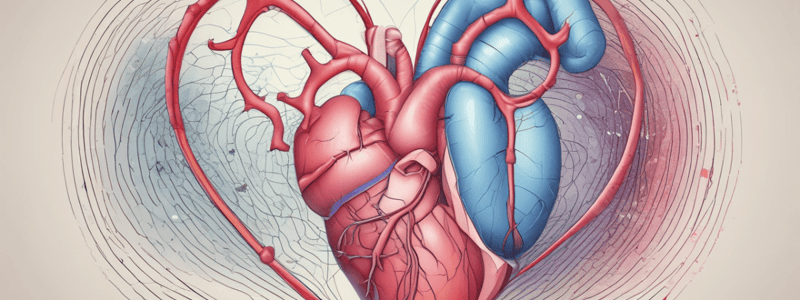Podcast
Questions and Answers
What is the primary method of detection for congenital heart defects in the prenatal period?
What is the primary method of detection for congenital heart defects in the prenatal period?
- Electrocardiogram (ECG)
- Magnetic Resonance Imaging (MRI)
- Fetal echocardiogram
- Prenatal ultrasound (correct)
Which of the following congenital heart defects is characterized by a left-to-right shunt and increased pulmonary blood flow?
Which of the following congenital heart defects is characterized by a left-to-right shunt and increased pulmonary blood flow?
- Coarctation of the Aorta
- Tetralogy of Fallot
- Atrial Septal Defect (correct)
- Patent Foramen Ovale
What is the common feature of congenital heart defects such as Atrial Septal Defect, Ventricular Septal Defect, and Patent Ductus Arteriosus?
What is the common feature of congenital heart defects such as Atrial Septal Defect, Ventricular Septal Defect, and Patent Ductus Arteriosus?
- Right-to-left shunt
- Increased pulmonary blood flow (correct)
- Cyanosis
- Decreased cardiac output
What is the primary reason why congenital heart defects do not typically cause cyanosis in the fetal period?
What is the primary reason why congenital heart defects do not typically cause cyanosis in the fetal period?
Which of the following syndromes is a common cause of congenital heart defects, including Atrial Septal Defect and Ventricular Septal Defect?
Which of the following syndromes is a common cause of congenital heart defects, including Atrial Septal Defect and Ventricular Septal Defect?
What is the typical gestational age at which congenital heart defects are screened for?
What is the typical gestational age at which congenital heart defects are screened for?
What is the primary reason for right ventricular dilation in patients with Atrial Septal Defect?
What is the primary reason for right ventricular dilation in patients with Atrial Septal Defect?
Which of the following is a characteristic of Primum ASD?
Which of the following is a characteristic of Primum ASD?
What is the effect of increased pulmonary artery hypertension on the lungs?
What is the effect of increased pulmonary artery hypertension on the lungs?
What is the difference between Atrial Septal Defect and Patent Foramen Ovale?
What is the difference between Atrial Septal Defect and Patent Foramen Ovale?
What is the cause of dyspnoea in patients with Atrial Septal Defect?
What is the cause of dyspnoea in patients with Atrial Septal Defect?
What is the characteristic murmur heard in patients with Atrial Septal Defect?
What is the characteristic murmur heard in patients with Atrial Septal Defect?
Which of the following is a risk factor for Atrial Septal Defect?
Which of the following is a risk factor for Atrial Septal Defect?
What is the consequence of increased venous congestion in patients with Atrial Septal Defect?
What is the consequence of increased venous congestion in patients with Atrial Septal Defect?
What is the characteristic murmur of a ventricular septal defect?
What is the characteristic murmur of a ventricular septal defect?
What is the consequence of a large ventricular septal defect?
What is the consequence of a large ventricular septal defect?
What is the effect of a ventricular septal defect on pulmonary artery pressure?
What is the effect of a ventricular septal defect on pulmonary artery pressure?
What is the common feature of a patent ductus arteriosus and a ventricular septal defect?
What is the common feature of a patent ductus arteriosus and a ventricular septal defect?
What is the mechanism that keeps the ductus arteriosus open in a patent ductus arteriosus?
What is the mechanism that keeps the ductus arteriosus open in a patent ductus arteriosus?
What is the characteristic of a small ventricular septal defect?
What is the characteristic of a small ventricular septal defect?
What is the consequence of a patent ductus arteriosus?
What is the consequence of a patent ductus arteriosus?
What is the most common congenital cardiac malformation?
What is the most common congenital cardiac malformation?
Flashcards are hidden until you start studying
Study Notes
Congenital Heart Defects
- Present from birth, detected through prenatal ultrasound (~30 years) at 20 weeks gestation
- Can be classified as cyanotic and acyanotic
- Most defects permit months of intrauterine life, resulting in live offspring at full term
Acyanotic Congenital Heart Defects
- Characterized by left-to-right shunt, where oxygenated blood flows to deoxygenated blood
- Does not cause cyanosis
- Increased pulmonary blood flow
- Common causes: Down syndrome, Foetal alcohol syndrome, Intrauterine infections
- May lead to stroke due to increased risks of blood clotting (paradoxical clot formation)
Ventricular Septal Defect (VSD)
- Membranous VSD (more common) and Muscular VSD
- Most common congenital cardiac malformation
- Left-to-right shunt, increased pulmonary artery hypertension (PAH)
- Large defects may lead to dilation of left atrium and left ventricle (displaced apex beat)
- Ventricular preload increases
- Holosystolic (or pansystolic) murmur at the left sternal angle, loud S2, and diastolic rumble (apical)
- Excess blood flowing through the mitral valve can be felt at the left sternal border
- Smaller VSDs create larger murmurs and vice versa
Patent Ductus Arteriosus (PDA)
- Blood from the aorta crosses the ductus arteriosus and flows into the pulmonary artery
- Continuous 'machinery' murmur best heard below the left clavicle
- Increased pulmonary artery pressure
- Left heart dilation (displaced apex beat) and volume overload
- Prostaglandins keep the ducts open
Atrial Septal Defect (ASD)
- Primum ASD, Secundum ASD (more common), and Sinus venosus defects
- Most common congenital heart defects found in adults
- Left-to-right shunt, excess blood in the right atrium and right ventricle
- Right ventricular dilation: parasternal heave, reduced CO, sympathetic activation
- Increased pulmonary artery hypertension (PAH) and pulmonary oedema
- Dyspnoea, recurrent chest infections, increased venous congestion, and raised JVP
- Systolic ejection murmur, fixed splitting of S2, and diastolic rumble
- Surgical repair may be necessary if volume is significant
Studying That Suits You
Use AI to generate personalized quizzes and flashcards to suit your learning preferences.




